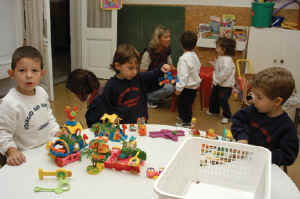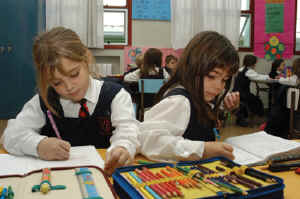
- Cápsula del tiempo
- Historia
- Cuerpo docente e instalaciones
- Grantfield
- English
- Deporte
- School Songs
- Alumnos destacados
- Transporte a Grantfield
- Home
- Ingresos 2026
- Sistema de alumnado
- HandBook 2026
- Nuestra Biblioteca en línea
- Plataforma VirtualMoodle
- Galería de imágenes
English

The final objective of Colegio San Bartolomé is to educate bilingual students.
We consider bilingual students to be those who, after being exposed to different approaches to
language acquisition and learning throughout their school life, achieve mastery of Spanish and English in such a way that they
are able to communicate in both languages, in oral and written form, with a high level of efficiency and proficiency, under
different circumstances.
At Colegio San Bartolomé, students start
being exposed to input in the English language at the early age
of 3. The topics developed are always connected with the
children´s immediate reality, becoming more complex in the
subsequent years of pre-primary schooling.

In Primary, lessons are taught solely in English, and students are fully exposed to the second
language four afternoons a week. They are engaged in authentic
and meaningful activities using the second language as a real
tool for communication.
At the end of Primary School students are enco/uraged and prepared to take the PET (Preliminary English Test) administered by the University of Cambridge.

Throughout Secondary, contents are
developed in an increasingly complex manner, and are built upon
subsequently. Students´ formal instruction of the language is
enriched by subject matter teaching in English through subjects
like Art, Geography, History and Literature.
As a way of accrediting the different
levels of linguistic competence accomplished, students sit for
internationally-recognised exams administered by Cambridge ESOL.
Along the years of Secondary, students achieve new and higher levels of linguistic competence-Level B2
F.C.E. (First Certificate Exam), Level C1 C.A.E. (Certificate in
Advanced English) and Level C2 C.P.E. (Certificate of Proficiency in
English). Some of them also choose to sit B.E.C. Vantage (Business English Certificate Vantage).
Students take these exams throughout the years, at the pace their own learning rhythms and
achievements allow.
Learning the language at this stage
continues being conceived not only as mastering the linguistic
code of the target language, but also as involving an
understanding of discourse competence, social contexts, roles of
participants and the functions of different kinds of
interaction.
All these possibilities that Colegio San
Bartolomé provides for its students account for the profile of
the graduate student being regarded as that of a «bilingual
student».